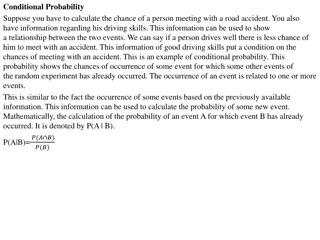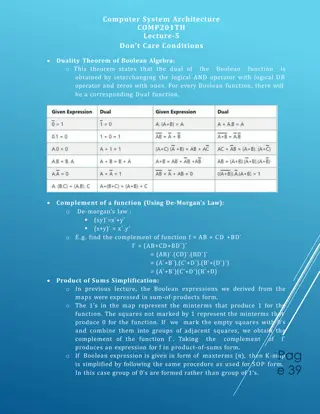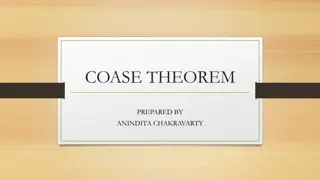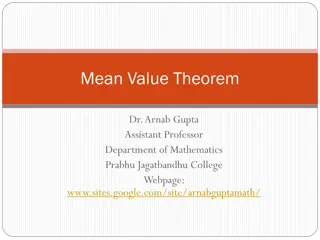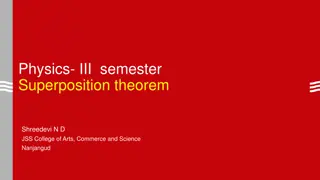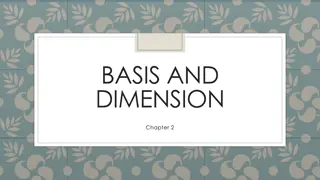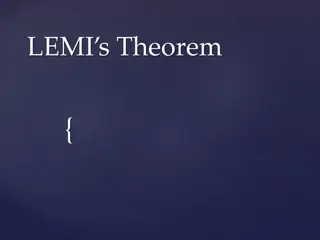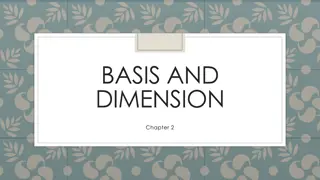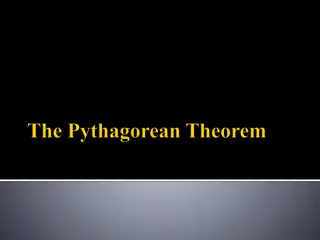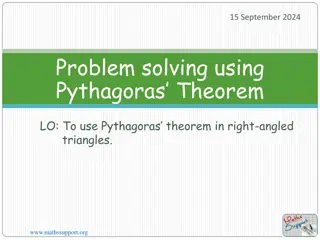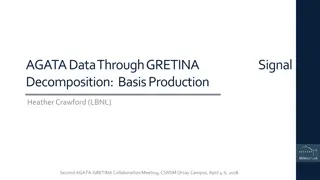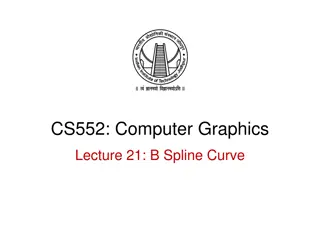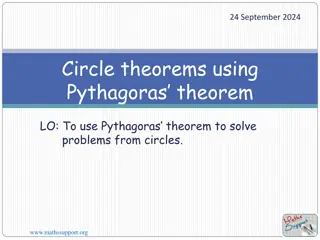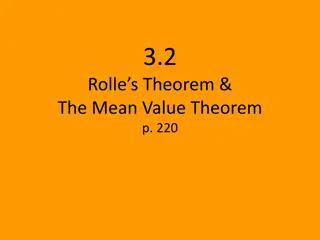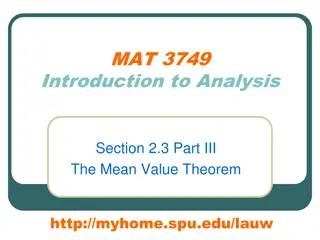
Understanding Basis and Properties in Linear Algebra
Explore the concept of basis in linear algebra, including its significance in defining subspaces, generating sets, and dimensions. Learn about properties of bases, theorems related to bases, and how they form the foundation of vector spaces.
Download Presentation

Please find below an Image/Link to download the presentation.
The content on the website is provided AS IS for your information and personal use only. It may not be sold, licensed, or shared on other websites without obtaining consent from the author. If you encounter any issues during the download, it is possible that the publisher has removed the file from their server.
You are allowed to download the files provided on this website for personal or commercial use, subject to the condition that they are used lawfully. All files are the property of their respective owners.
The content on the website is provided AS IS for your information and personal use only. It may not be sold, licensed, or shared on other websites without obtaining consent from the author.
E N D
Presentation Transcript
Basis Why nonzero? Let V be a nonzero subspace of Rn. A basis B for V is a linearly independent generation set of V. {e1, e2, , en} is a basis for Rn. 1. {e1, e2, , en} is independent 2. {e1, e2, , en} generates Rn. {1 0,0 1} is a basis for R2 {1 3, 3 {1 1 } {1 1,1 any two independent vectors form a basis for R2 1, 1} 2} 1
Basis The pivot columns of a matrix form a basis for its columns space. RREF pivot columns Col A = Span
Property Basis is always in its subspace (a) S is contained in Span S (b) If a finite set S is contained in Span S, then Span S is also contained in Span S Because Span S is a subspace Span S Span S (c) For any vector z, Span S = Span S {z} if and only if z belongs to the Span S z z
Theorem 1. A basis is the smallest generation set. 2. A basis is the largest independent vector set in the subspace. 3. Any two bases for a subspace contain the same number of vectors. The number of vectors in a basis for a nonzero subspace V is called dimension of V (dim V).
Every basis of Rn has n vectors. Theorem 3 The number of vectors in a basis for a subspace V is called the dimension of V, and is denoted dim V The dimension of zero subspace is 0 dim R2 =2 dim R3=3
Example Find dim V dim V = 3 ?1= 3?2 5?3+ 6?4 Independent vector set that generates V Basis?
More from Theorems Any two bases for a subspace contain the same number of vectors. Rm have a basis {e1, e2, , em} All bases have m vectors dim Rm = m A basis is the smallest generation set. A vector set generates Rm must contain at least m vectors. Because a basis is the smallest generation set Any other generation set has at least m vectors. A basis is the largest independent set in the subspace. Any independent vector set in Rm contain at most m vectors.
Theorem 1 A basis is the smallest generation set. If there is a generation set S for subspace V, The size of basis for V is smaller than or equal to S. Reduction Theorem There is a basis containing in any generation set S. S can be reduced to a basis for V by removing some vectors.
Theorem 1 Reduction Theorem generation set basis S can be reduced to a basis for V by removing some vectors. Suppose S= {u1, u2, , uk} is a generation set of subspace V Subspace ? = ???? ? = ??? ? Let A = [ u1u2 uk ]. The basis of Col A is the pivot columns of A Subset of S
Theorem 1 Reduction Theorem generation set basis = ??? ? = Span Subspace ? = ???? ? 1 3 0 3 2 6 3 9 1 2 2 2 2 0 1 1 3 2 Smallest generation set 1 2 3 2 4 6 ? = , , , , , Generation set RREF ? =
Theorem 2 A basis is the largest independent set in the subspace. If the size of basis is k, then you cannot find more than k independent vectors in the subspace. Extension Theorem Given an independent vector set S in the space S can be extended to a basis by adding more vectors
Theorem 2 Extension Theorem Independent set: basis basis There is a subspace V Given a independent vector set S (elements of S are in V) If Span S = V, then S is a basis If Span S V, find v1 in V, but not in Span S S = S {v1} is still an independent set If Span S = V, then S is a basis If Span S V, find v2 in V, but not in Span S S = S {v2} is still an independent set V You will find the basis in the end.
Textbook P245 Null B Theorem 3 Null C Any two bases of a subspace V contain the same number of vectors Suppose {u1, u2, , uk} and {w1, w2, , wp}are two bases of V. Let A = [u1u2 uk] and B = [w1w2 wp]. Since {u1, u2, , uk} spans V, ci Rk s.t. Aci = wi for all i A[c1c2 cp] = [w1w2 wp] AC = B Now Cx = 0 for some x Rp ACx = Bx = 0 x= 0 c1c2 cp are independent ci Rk p k B is independent vector set Reversing the roles of the two bases one has k p p = k.
Theorem 4.9 (P258) If V and W are subspaces of Rn with V contained in W, then dim V dim W If dim V = dim W, V=W Proof: BV is a basis of V, V in W, BV in W BV is an independent set in W dim V dim W By extension theorem, BV is in the basis of W If dim V = dim W =k BV is a linear independent set in W, with k elements It is also the span of W
R3 is the only 3-dim subspace of itself L W The 2-dim subspace with basis {u,v} u The 0-dim subspace v 0 The 1-dim subspace with basis {u}
Concluding Remarks 1. A basis is the smallest generation set. 2. A basis is the largest independent vector set in the subspace. 3. Any two bases for a subspace contain the same number of vectors. The number of vectors in a basis for a nonzero subspace V is called dimension of V (dim V).
Concluding Remarks Same size Independent vector set Generation set Basis (from wiki)

